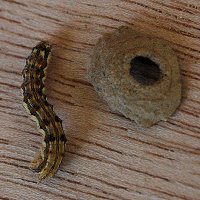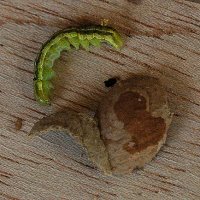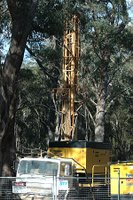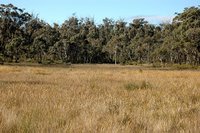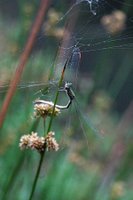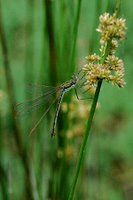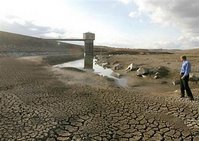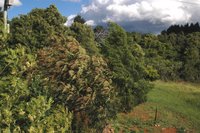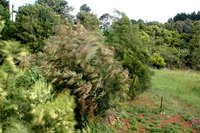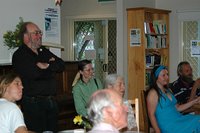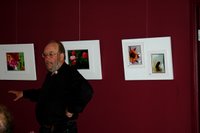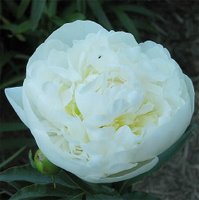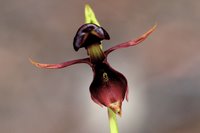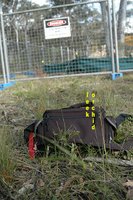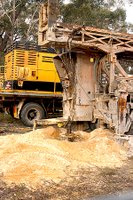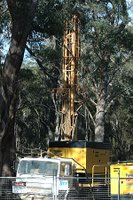If you want to have a look, I suggest you start with Butterfly Larvae of Australia:
http://linus.socs.uts.edu.au/~don/larvae/butter.html
If you scroll to the bottom of any page, you will find links to "Caterpillars of Australian Moths" and to "Caterpillar FAQs".
It is a great resource - with a mountain of information. Most pages have photos of adults (Butterflies or Moths) and their immature stages - caterpillars.
*****
Don's websites enabled me to hazard a guess that my caterpillars, from yesterday's story were of an introduced pest moth in the Helicoverpa genus. I wrote to Don Herbison-Evans yesterday, I said:
Dear Don,
I am enclosing some photographs of 2 caterpillars which I found inside a Mud Wasp nest, which my daughter asked me to remove, as they were on the glass on her window - and she judged the Wasps to pose a risk to her.
I would not normally break open a wasp nest, nor kill the larvae inside, but the location of the nest made this a question of safety, (in my daughter's opinion).
I am writing to ask if it is possible to identify the type of caterpillars in these Mud Wasp nests? I am guessing that they might be something like the Helicoverpa caterpillars, as per your illustrations on:
http://linus.socs.uts.edu.au/~don/larvae/heli/armi.html
I would not normally break open a wasp nest, nor kill the larvae inside, but the location of the nest made this a question of safety, (in my daughter's opinion).
I am writing to ask if it is possible to identify the type of caterpillars in these Mud Wasp nests? I am guessing that they might be something like the Helicoverpa caterpillars, as per your illustrations on:
http://linus.socs.uts.edu.au/~don/larvae/heli/armi.html
*****
Tonight I got this reply back. (Thanks Don, for such a prompt reply.)
Hi Denis,
Very good: yes I think that your wasps are doing a good job keeping the pest Helicoverpa armigera under control, as your illustrated caterpillars appear to be this species. I doubt that the caterpillars are feeding on the Acacia or Doryphora, but are more likely on various herbaceous plants in the understory or open areas.
Your mud wasps are mainly from the family SPHECIDAE, and can deliver a painful sting if annoyed, but being solitary you only have to fend off one beastie. In this way they are less of a threat than the communal wasps (family VESPIDAE) where one needs to fend of dozens if they get annoyed.
Cheers,
Don
Hi Denis,
Very good: yes I think that your wasps are doing a good job keeping the pest Helicoverpa armigera under control, as your illustrated caterpillars appear to be this species. I doubt that the caterpillars are feeding on the Acacia or Doryphora, but are more likely on various herbaceous plants in the understory or open areas.
Your mud wasps are mainly from the family SPHECIDAE, and can deliver a painful sting if annoyed, but being solitary you only have to fend off one beastie. In this way they are less of a threat than the communal wasps (family VESPIDAE) where one needs to fend of dozens if they get annoyed.
Cheers,
Don
*****
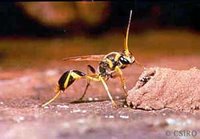 Wow, two answers, not just one: The species of Moths (I guessed correctly, based on Don's wonderful website (that is a very satisfying thing).
Wow, two answers, not just one: The species of Moths (I guessed correctly, based on Don's wonderful website (that is a very satisfying thing).
 Wow, two answers, not just one: The species of Moths (I guessed correctly, based on Don's wonderful website (that is a very satisfying thing).
Wow, two answers, not just one: The species of Moths (I guessed correctly, based on Don's wonderful website (that is a very satisfying thing). Plus, I get the family of the Mud Wasps identified too - just from their nest, and their habits.
Fantastic.
I want you all to go to one of those links above, and then "bookmark" it, or save it to "Favourites" - or whatever terminology your computer uses. From one site, you can always jump across to the others. These sites are a "Gold Mine" of photographs, and information. It is especially useful for residents of the Southern highlands, as we are blessed with an abundance of wonderful Moths, in particular. And they are so beautiful, and so intricate in design.
Love your local Moth, I say.
I want you all to go to one of those links above, and then "bookmark" it, or save it to "Favourites" - or whatever terminology your computer uses. From one site, you can always jump across to the others. These sites are a "Gold Mine" of photographs, and information. It is especially useful for residents of the Southern highlands, as we are blessed with an abundance of wonderful Moths, in particular. And they are so beautiful, and so intricate in design.
Love your local Moth, I say.
*****
In fact, you do not have to love this particular Moth, as it is a pest species.It is known variously as the Corn Ear Worm, Tomato Grub, Tobacco Budworm, Cotton Bollworm. It is in the family: HELIOTHINAE, of the Order: NOCTUIDAE


